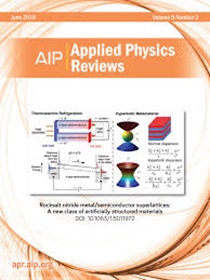A flexible phototransistor with simultaneous high mobility and detectivity
IF 11.9
1区 物理与天体物理
Q1 PHYSICS, APPLIED
引用次数: 0
Abstract
Phototransistors have great application prospects in automotive vehicle, smart home, healthcare, imaging, and display. However, so far, there has been no report of flexible phototransistors that simultaneously achieve both high mobility and detectivity. Additionally, phototransistors are conventionally relied on thick channel layers and previous thin channel layers based devices only show poor performance. Here, we report flexible phototransistors based on ultrathin niobium-doped indium oxide (InNbO, 5 nm)/indium tin oxide (ITO, 3 nm) channel layers, which possess high mobility (49.21 cm2 V−1 s−1) and high detectivity (3.02 × 1014 Jones) simultaneously. Significantly, the devices offer a broad spectral responsivity (from violet to green emissions). We postulate that the high mobility can be ascribed to the diffusion of Sn atoms (from ITO) and conduction band offset (between InNbO and ITO), while the high detectivity originates from the low dark current. To illustrate the capabilities of flexible phototransistors, we demonstrate both a flexible active-matrix organic light-emitting diode display pixel circuit and an imaging system. Our approach unlocks new possibilities to achieve flexible phototransistors with superior performance, which suggest a great potential in next-generation flexible, stretchable, bendable, and low-cost electronics.一种同时具有高迁移率和高探测性的柔性光电晶体管
光电晶体管在汽车、智能家居、医疗保健、成像、显示等领域具有广阔的应用前景。然而,到目前为止,还没有柔性光电晶体管同时实现高迁移率和高探测性的报道。此外,光电晶体管传统上依赖于厚沟道层,而以前基于薄沟道层的器件仅表现出较差的性能。在这里,我们报道了基于超薄掺铌氧化铟(InNbO, 5 nm)/氧化铟锡(ITO, 3 nm)通道层的柔性光电晶体管,同时具有高迁移率(49.21 cm2 V−1 s−1)和高探测率(3.02 × 1014 Jones)。值得注意的是,该设备提供了广泛的光谱响应(从紫色到绿色的发射)。我们假设高迁移率可归因于锡原子的扩散(来自ITO)和导带偏移(在inbo和ITO之间),而高探测性源于低暗电流。为了说明柔性光电晶体管的能力,我们展示了柔性有源矩阵有机发光二极管显示像素电路和成像系统。我们的方法为实现具有卓越性能的柔性光电晶体管提供了新的可能性,这表明下一代柔性,可拉伸,可弯曲和低成本电子产品具有巨大潜力。
本文章由计算机程序翻译,如有差异,请以英文原文为准。
求助全文
约1分钟内获得全文
求助全文
来源期刊

Applied physics reviews
PHYSICS, APPLIED-
CiteScore
22.50
自引率
2.00%
发文量
113
审稿时长
2 months
期刊介绍:
Applied Physics Reviews (APR) is a journal featuring articles on critical topics in experimental or theoretical research in applied physics and applications of physics to other scientific and engineering branches. The publication includes two main types of articles:
Original Research: These articles report on high-quality, novel research studies that are of significant interest to the applied physics community.
Reviews: Review articles in APR can either be authoritative and comprehensive assessments of established areas of applied physics or short, timely reviews of recent advances in established fields or emerging areas of applied physics.
 求助内容:
求助内容: 应助结果提醒方式:
应助结果提醒方式:


